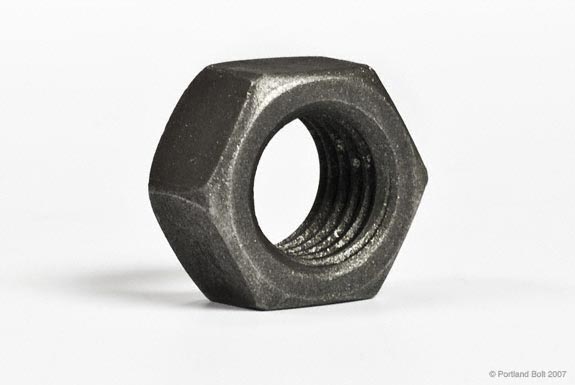 A standard hex nut, also referred to as a finished hex nut, has a smaller width across the flats and corners compared to a heavy hex nut, and a heavy hex nut is slightly thicker than a standard hex nut of the same nominal size. In fact, heavy hex nuts are exactly a 1/8” larger across the flats than a standard hex nut in all sizes, requiring a 1/8” larger socket or wrench to install. Also, heavy hex nuts have a higher proof load strength compared to a hex nut according to ASTM A563.
A standard hex nut, also referred to as a finished hex nut, has a smaller width across the flats and corners compared to a heavy hex nut, and a heavy hex nut is slightly thicker than a standard hex nut of the same nominal size. In fact, heavy hex nuts are exactly a 1/8” larger across the flats than a standard hex nut in all sizes, requiring a 1/8” larger socket or wrench to install. Also, heavy hex nuts have a higher proof load strength compared to a hex nut according to ASTM A563.
A563 Mechanical Properties
| Grade | Style | Size, in. | Proof Load, ksi | Hardness, HBN | |
|---|---|---|---|---|---|
| Plain | Galvanized | ||||
| A | Hex | 1/4 - 1-1/2 | 90 | 68 | 116 - 302 |
| Heavy Hex | 1/4 - 4 | 100 | 75 | 116 - 302 | |
| B | Heavy Hex | 1/4 - 1 | 133 | 100 | 121 - 302 |
| Heavy Hex | 1-1/8 - 1-1/2 | 116 | 87 | 121 - 302 | |
| C / C3 | Heavy Hex | 1/4 - 4 | 144 | 144 | 143 - 352 |
| D | Heavy Hex | 1/4 - 4 | 150 | 150 | 248 - 352 |
| DH / DH3 | Heavy Hex | 1/4 - 4 | 175 | 150 | 248 - 352 |
| For UNC, 8UN, 6UN, and Coarse Pitch Threads | |||||
By default, the ASTM A194 nut specification requires the dimensions to conform to the American National Standard Heavy Hex Series unless noted otherwise.
Alternatively, the ASTM F594 nut specification calls for the dimensions to be in accordance with ASME B18.2.2 for Hex Nuts.
Lastly, ASTM A563 requires the style of nut (for example, heavy hex) to be listed on the inquiry. However, All A563 nuts will be heavy hex by default except for Grade A in sizes 1/4”-1-1/2” diameter.

I´M LOOKING FOR 1/2″ HEVY HEX NUT ASTM A563 DH3
ABOUT 1000PC
@Alfonso- We are not aware of anyone stocking 1/2″ diameter A563 DH type 3 nuts. We can supply as 5/8″ or larger only.
We use A307 Gr.B stud bolts and A564 Gr,A heavy nuts for water flanges. wewant to change the studs and nuts into metric size. Since A563m CL.5 is similar to A563 Gr.A in proof load stress and hardnes. Why A563M indicate CL.5 nut size less than M36 should be hex nuts. Can A563M CL.5 to replce A563 Gr.A for heavy nuts. Thank you.
@Chun- We are not certain why that portion of the A563M standard is written that way. We are also unsure of what is available in the marketplace in regards to A563M nuts, as we do not typically get involved with them. Our hunch is that, much like the smaller imperial sized nuts, a standard hex is much more common. You might be able to have the larger sized nuts manufactured, or perhaps you are able to use a higher grade of A563M nut that comes in a heavy hex pattern.
#Dane_McKinnon Thank you for the kind reply.
That’s what we so about the temperature service is not hot enough to weld the bolt and nut, So we doubt in the bolting procedure if you have any experience in this way relating to the method statement and tightening value have to share with us.
Thanks,
High Importance!!!!
Request technical support
In our work site we have a problem in the standard bolt way, when removing the shell end cover for the tube inspection on the Exchanger equipment during a inspection work activities, we continuously encounter problems releasing the Nuts from the Bolt stud (welded and cut off).
These exchangers operate at high temperature ( between 160 to 280 Co) which causes the Bolt Studs and Nuts to fuse together & the only way to operate them is to cut the Bolt Stud.
The specification of these Bolts 1″ 1/8 x440 mm (A320 GR L7)/ 2H (A194 GR 4).
Please waiting your feedback ASAP.
Thank you in advance.
Regards,
@Samir- 160-280C is not hot enough to weld the bolt and nut, so there must be other factors at play that are causing these to fuse together. We do not have any engineers or metallurgists on staff, so unfortunately will be unable to help with this. Apologies.